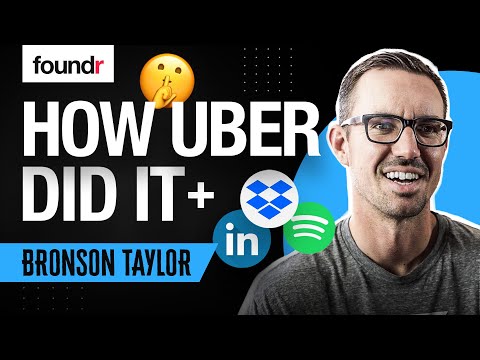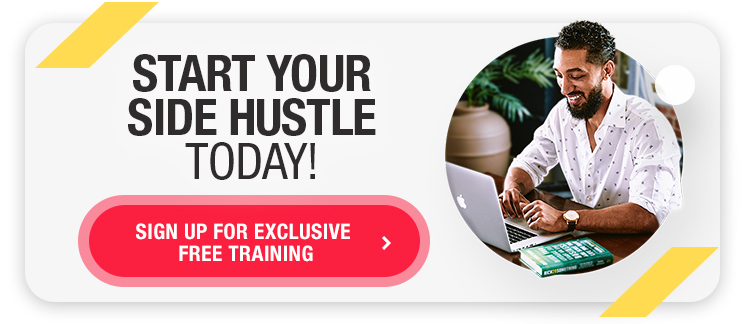Times are bleak, and it’s comforting to think about building something new. But how do you decide on the right business idea? How long will it take to bring in profits? If you’re looking to explore businesses that make money right away, you’ve come to the right place.
You’ve probably skimmed plenty of listicles by now that make it seem oh-so-easy to just start a successful blog, or sell ads on YouTube, or tap into brands’ influencer marketing budgets while living the laptop life. Or you have multiple “passive income” streams while you sit by the pool and watch the sales notifications pour in.
One superpower you should always hone as an entrepreneur is the ability to spot these opportunities—identifying trends in the marketplace, and solving top-tier problems that are keeping your customers up at night.
At Foundr, we stand by our motto that starting a business is easy, but building a business is hard. That said, there are some cheap businesses to start with low risk, and some have a quicker setup time than others.
Businesses That Make Money Right Away
3. Online Clothing Consignment
5. Start an Online Store (Ecommerce)
6. Starting a Saas Product or App (Beta)
Here are our 7 businesses that make money right away, and how long each one really takes to start bringing in your first sales.
1. Freelancing or Consulting
Zero to Profit: 1-2 weeks
The #1 quickest way to bring in revenue immediately is to start freelancing or consulting. Whatever you want to call it, whether it’s a one-person operation or a budding agency, this simply means that you are selling a service rather than a product.
There are no startup costs, and no overhead. Literally, all you need to start your side hustle is your skills and an internet connection.
Solving Pain
The key thing that’s important to figure out before you get into freelance work is: what’s the pain point you’re going to solve? This will give your business a focused direction.
Here are some easy methods to identify these pain points:
- What burning questions do people often ask you? What are the things keeping them up at night, that they simply can’t solve?
- Scan through Quora and Reddit. What threads are blowing up? Are there specific problems people are experiencing? Questions that more than five or ten people are asking?
- What questions do people often ask you in your job, friend group, or personal life? What topics are you typically the “go-to” for advice?
- Look through relevant Facebook Groups, LinkedIn, and your Twitter feed. What complaints or frustrations keep popping up?
- Look on Amazon, and go to the Reviews section of a given book (preferably something in the niche that you’re interested in). Filter down to the 2- and 3-star reviews. These are typically the more detailed reviews, stating things that could’ve been better, or things that they wish the book covered. What trends are you seeing?
How Much to Charge
There are three core business models when it comes to charging for freelance services.
- Hourly Rate
- Project Fee
- Retainer
An hourly rate is simply that—you charge a certain dollar amount for every hour worked. You keep track of your hours in a timesheet (or a tool like AND.CO) and send your client an invoice at the end of each month.
A social media manager just starting out might charge $20-$40 an hour, while a video editor or graphic designer with a few years experience might charge $30-$50 an hour (up to $100 an hour for senior level). This number shouldn’t be arbitrary—more on that later.
A project fee is a simpler “lump sum” that you charge a client based on an estimated amount of hours worked. Presumably, this adds up in your favor, but feels like it’s discounted in their favor. This model works out well when the deliverable is a clear singular project, like a website design or an illustration or a written blog article.
Project fees can also be helpful to simplify things and guarantee future payment upfront, rather than waiting to see how many hours you spent. For example, you might be developing a social media strategy and launch plan for a brand, which encompasses a variety of skills (copywriting, graphic design, strategy, community management, customer support, project management). This would be cumbersome to track time across five different hats, each with unique hourly rates. So instead, you estimate a project fee of $9,600 for 3 months’ work (approx. 20 hours a week @ the highest hourly rate of $40), all-inclusive through to the launch.
A retainer is a monthly fee that you charge a client in order to retain you as their service provider. The retainer model is often used by lawyers, ad agencies and marketing agencies because they provide repeat service. It’s uncommon for individual freelancers to have a retainer at first (you’ll have to earn this trust from your client over time).
Start small with an hourly rate or project fee, then after a few months you can discuss retainer. (Editor’s note: There is a 4th model in which you charge a percentage of media spend, but this is specific to digital marketing agencies so we won’t get into the details here.)
Yes, you can mix and match these business models. For example, you might charge a monthly retainer fee of $1,000 to be “on call” up to a certain number of hours per month, plus an hourly rate for any time worked beyond the retainer agreement.
Or, you might start out with an hourly rate of $30/hour until you hit a certain workload capacity, and then transition into a project fee after that. Frame this to your client as “value-added” or “cost savings” on their part.
For an in-depth guide on how much to charge for consulting services, check out this article.
How to Find Freelance Clients
This may seem like the tricky part, but it can be easier than you think. Finding freelance clients or people to consult is not some unsolved mystery.
There are literally hundreds of millions of people out there who are experiencing problems. These people will happily pay money to have those problems solved. You just have to connect with those people, figure out what their problems are, and present a solution to them in a way such that the perceived value is 10x higher than the price.
In other words, if your service leads to $10,000 in value for them, the price of that service should be $1,000 going to you.
Foundr has a great resource on how to get consulting clients or freelance leads.
For now, all you need to know is 10%-20% more than the people whom you are serving. There’s no need to be an expert, or have a masters degree in that particular field.
You just need the confidence that you know a little bit more than your client prospects, and the desire to help alleviate their pain.
No Overhead
You can run a freelancing operation or consulting agency without taking on any overhead at all.
You won’t have to pay for office rent. You can start with no employees (just yourself and your skills), which means no extra payroll taxes. There’s no manufacturing or product development. No physical storage of inventory.
The only recurring fees you’ll need to cover as a freelancer or consultant are:
- Your WiFi connection
- Whatever SaaS tools you use in order to actually do the work (e.g. Adobe Creative Suite for designers and video editors, Ahrefs or MozPro for SEO content managers)
- Your website builder (e.g. Squarespace) and hosting fee (e.g. GoDaddy), if you have a landing page or portfolio to bring in new business
All-in you’re looking at a monthly cost of only $150-$250 at the absolute max.
Translation: 99% profit.
Not a bad margin! And definitely, a go-to business model that makes money right away.
2. Online Coaching
Zero to Profit: 3-4 weeks
Think of this like “the new speaking gig.” Remember in-person conferences and workshops? Well, you can translate this into the post-pandemic digital world by offering the same quality of content on video chat.
Use Remote to Your Advantage
The beauty of being in the comfort of your home, rather than on somebody else’s stage, is that you have complete control.
You’re not reliant on someone else’s audio-visual system. Or microphone that wavers in and out. Or a daunting room full of staring audience members, some of which are coughing and going to the bathroom and sneaking out for calls.
By hosting a digital event in your own space, you can design your environment for success and have everything at your fingertips, with no added stress of the unknown.
Here are some thought-starters for making money right away:
- Live panel or fireside chat (gather up 3 experts and host a facilitated discussion)
- 1-on-1 coaching
- Webinar
- 6-week bootcamp
- Exclusive interview or live podcast (if you already have a pre-recorded podcast, do one episode “live” to make it special and scarce, and charge a ticket fee)
- Standup comedy
- TEDx for _____
Treat it Like it’s Still In-Person
Another thing you can use to your advantage when hosting a paid video call as an event is to over-prepare, as if it were still a physical event.
Spend time designing your curriculum or slide deck. Have your notes handy. Research your guests (if you’re hosting others). Come up with fun ways to invite audience participation (e.g. “type ____ into the chatbox if you’re ____”).
But over-preparedness doesn’t mean you should sound like a scripted robot.
Sure, you can have your second monitor or iPad with your notes on it, and nobody will be the wiser. But you should still riff extemporaneously, engage with the audience in organic ways, and create the vibe that we’re all in the same room.
If you create something so memorable that people tell their friends (by screenshotting it and posting on their Instagram stories, for example), you’ve just tapped into a powerful marketing strategy: Word-of-mouth on steroids.
Build Your Personal Brand
In the same way that you would build up your personal brand and online presence to land speaking gigs IRL, you can leverage your social media channels to brand yourself as a thought leader in your niche.
We’ve seen thousands of students in our Instagram Domination training who have landed 5-figure speaking engagements and even 6-figure book deals, simply by growing their Instagram following. You can do this too!
3. Online Clothing Consignment
Zero to Profit: 1-4weeks
Did you know that 11M tons of textile waste head to landfills every year?
The clothing and fashion industries are some of the most profitable and wasteful on the planet. The environmental costs of “fast fashion” have changed the behaviors of clothing customers, with more demand than ever before for upcycled, refurbished, and reused clothing. The change in consumer behavior creates a huge market for buying and selling used clothing. By 2026, the secondhand apparel market is expected to double to $218B. Here’s how you can capitalize on that growth.
Sell What You Have
The fastest way to make revenue through clothing is by selling what you have on Facebook Marketplace or thredUP. All you need to do is have an eye for brands and style with the ability to take quality product imagery on your phone. “Marie Kondo” your closet, and you’ll be surprised how much value is just sitting on hanging racks.
Start an Online Consignment Store
If you want to bring your clothing business to the next level, then start an online store via Shopify or Etsy. Once your store is live, start building your inventory by scouring local thrift stores, Facebook Marketplace, or eBay for pieces that can be refurbished (or marketed) to your audience.
Have a Niche Focus
It won’t be easy with larger online retailers and resellers, so creating a niche is the best way to stand out online. Here are a couple of ideas to get started:
- Specialize in a specific type of clothing like vintage denim.
- Associate your products with runway lines.
- Focus your products around high-volume search topics like “refurbished dresses.”
- Build your brand around your environmental practices
Build a Community
Clothing is personal and expressive. Build a community around your brand through interactions with your customers. For example, encourage them to post photos of the refurbished clothing or create an environmental impact tracker on your website. If you build a community around your clothing brand, you’ll build loyalty that will think about buying from you first before going to a box store or fast fashion brand.
4. Creating Online Courses
Zero to Profit: 1-2 weeks (first pre-sales); 2 months (launch)
The online education revolution is here.
But creating online courses as a business model, however, is easier said than done. That’s why this article states “two months” to launch, because this is what it takes to do it right.
In order to provide true value for your students, and create an online course that’s evergreen and will stand the test of time (i.e. not some fly-by-night topic that will expire with the next algorithm change or fashion trend), there is a certain technique to designing a successful online training.
That said, you can certainly bring in sales faster than two months. We’ve seen pre-sales for online courses ring in after only two weeks. Here’s how.
Validate Your Topic Before Diving Into Production
The most powerful form of validation is when someone whips out their credit card and buys your product before it even exists. This is the thinking behind crowdfunding platforms like Kickstarter and Indiegogo. And you can use it to your advantage to fuel your online course production.
By pre-selling your course topics before you produce the videos, you are effectively:
- Guaranteeing that there is a market for that course topic
- Separating the wheat from the chaff and curating the best topic to move forward with (killing the ones with the least pre-sales)
- Securing a close-knit “beta group” of pre-buyers whose brains you can tap into throughout the process as you develop your course content
- Bringing in cash right away to validate that you’re headed in the right direction (this is a hell of a confidence booster, too!)
How to Ethically Pre-Sell Online Courses
Here is Foundr’s 4-step framework for validating course topics, and ethically bringing in revenue before your online course exists.
1. First, send out a survey. This could be through your email list (if you have one) and/or your social following. Make sure it’s not just friends and family, unless you plan to make those people your customers too.
Ask them 5-10 questions. Dig into their pain points. Find out what they really want to know. What problems and burning questions are keeping them up at night? What is their biggest challenge right now?
These insights will come in handy later as you “cook to order” so that your course’s instructional design is written in their words and solves their specific needs.
2. Analyze the survey data and “product-ize” those insights. What I mean by this is, re-package the problems into semi-branded solutions.
For example, if 30 people tell you their biggest challenge right now is staying focused and getting work done during quarantine, maybe your course name has the word “productivity” in it? Or “WFH.” Or “Remote work.” You get the idea.
Once you nail down 3-5 or even 10 potential “products,” write down three bulletpoints for each that detail the benefits of that course. What can people expect to learn if they buy this course? What are the key takeaways? What are the most exciting lessons?
3. Pre-sell those course topics. You can set up a very basic landing page and checkout cart, and email this pre-sale campaign out to the same exact people whom you surveyed in step 1.
Ideally, this process will show you a clear winner (the course with the most pre-buyers), and you can table or kill the other topics for now that didn’t get sales. It’s important to stay focused.
4. Refund the people who bought a non-validated course topic, or offer to transfer their credit to the course that will get produced. This is very important, so that you don’t come off like you’re just taking people’s money.
Keep an open and honest conversation with your pre-buyers throughout the process. Chat with them on the phone to gather more insights. Craft the instructional content around their specific needs. And keep them in the loop for when your product is ready, so that they are the first people to get access!
Produce Your Course at Home with Screencasting
Gone are the days when you needed a “MasterClass quality” production with a 40-person film crew in order to provide educational value. As a video producer myself, this pains me to admit— but you can create an incredibly valuable online course with a slide deck and Quicktime.
Content is still king. And pedagogical value trumps camera skills, especially during lockdown. Even news anchors and late night TV hosts are using a very simple one-camera or webcam setup in their homes, on national television.
Read More: How to Create an Online Course Like Foundr
We also recommend you watch this video below where Foundr CEO Nathan Chan reveals the inside scoop on what no one tells you about creating online courses. Foundr’s business model involves offering in-depth, highly valuable online courses so he is well-acquainted with what it takes to achieve success.
As long as you spend the time upfront to craft your educational content in a way that’s clear, cohesive, and actionable, and stay focused on solving your customers’ pain, you will end up with some very happy students.
Best Online Course Platforms
When it comes to hosting your online course, there are two main routes: Publisher vs. Platform.
A “Publisher” tool is where you can self-publish and host your course, and you typically pay a monthly SaaS fee in exchange for use of this tool, similar to a website builder. Publisher model allows you to keep the majority of the revenue you bring in for your course, but you are also responsible for doing all your own marketing.
Publisher Tools for Online Courses:
A course “Platform” is a large on-demand education site, usually community-driven and more reminiscent of a social network than an individual course Publisher. The user experience is consistent across the site (think: YouTube or Netflix for education). For this reason, there are fewer branding opportunities to make your course stand out from the other 10,000+ on the platform. You can customize your video thumbnail, headline and description, and that’s about it.
You also split your revenue with the platform, with anywhere between 50%-80% of your course income going to the company. In exchange, the upside of these platforms is that they have a built-in audience that is already expecting educational content, so you have a head-start on the marketing rather than building your audience from scratch.
Read more: 6 Ways to Evaluate Online Business Courses Before You Buy
Platforms for Online Courses:
Make it 10X Better than the Competition
A lot of online course creators out there are doing a cash grab in exchange for very thin, fluffy content. Don’t be that guy. In order to really separate yourself from the pack, and create a truly valuable course that people will pay money for—and get results from—it’s important to go deeper.
Analyze the burning questions and pain points your audience is asking about. Work those answers into your course content. Use the specific language your audience uses, so that the videos are in their words.
Prioritize depth over breadth. Don’t make a listicle style video series that barely dips its toes into 65 different topics. It’s better to go deep on one topic, and break down the over-the-shoulder process of how to actually do that thing, vs. trying to cram too many topics into one course and not really providing anything of value.
For example, if your course is called “How to do your taxes as a freelancer,” you should screenshare the step-by-step process and actually SHOW your audience each step. What you shouldn’t do is simply offer “10 tips for tax season.” This is a blog article, not a course.
Produce It Once, Sell It Forever
Perhaps the best part about creating online courses as a business model is that, if done correctly, you can produce the content one time, and sell it over and over again. If you follow Foundr’s framework for producing in-depth online courses that are evergreen, you shouldn’t have to touch the product again for 6-12 months, maybe even longer.
From there, it’s all about the marketing—which can be a really fun process. It’s especially enjoyable when armed with the confidence that you already put in the work, and have a great course that genuinely helps people.
By combining our Pre-Sale Validation Method (1-2 weeks) and a “lean” course production process like screencapture at home, you can have your polished course out there into the world and launched within two months.
5. Start an Online Store (Ecommerce)
Zero to Profit: 3 months
This is by far one of our favorite business models in the Foundr community, and we’ve seen tens of thousands of students build successful online stores through our training programs.
I won’t dig into too much detail on the “how” here, as we have countless ecommerce resources available to you for free:
- YouTube Playlist: Starting and Growing an Ecommerce Business
- Interactive Guide: The Ultimate Guide to Starting and Scaling an Ecommerce Business
- Free Training: Learn How You Can Start a Profitable Online Store (in 12 Weeks or Less)
But I wanted to touch on the realistic time horizon you can expect, if this is a business model you’re thinking of exploring. After all, this article is about businesses that make money right away.
Simple, Not Easy
One misconception about starting an ecommerce store is that it’s quick and easy. Sure, it can be simple, if you follow a proven framework like what four-time multimillion-dollar founder Gretta van Riel has done with SkinnyMe Tea, Drop Bottle, The 5th Watches, and Skintox.
Part of that framework starts with a winning product idea. Here’s some information on how to choose a profitable idea from Gretta herself:
In addition to finding a winning product idea, there is a repeatable way to do it all: validate your idea, build your brand and audience, and launch your store to paying customers.
But ecommerce requires more logistics than say, a service-based business or digital content-based business. You’ll need to do product prototyping, manufacturing, packaging, shipping, and a number of other physical tasks that take a bit more time.
You can do a lot of it remotely and find a 3PL (3rd Party Logistics) partner to take on the brunt of it for you. The marketing aspect can also be done 100% remotely, to the point where you can run your business from your phone if you want to—and Foundr’s ecommerce training teaches you all this and more.
We just wanted to be 100% honest with you about the timing for this kind of business, in case you’re in a situation where you need cash next week.
From Idea to Launch in 3 Months
Based on what we’ve seen across thousands of businesses in the Foundr community, launching an ecommerce store typically takes about 12 weeks (~3 months). That’s from nailing down your idea, all the way through to bringing in your first sales.
It’s a very exciting process, especially that first time you get to hold your product in your hand and unbox something you designed yourself. There are also a number of marketing opportunities to make your business growth easy (e.g. influencer marketing, Instagram marketing), since the product is tangible and visual.
So if you’ve got some savings in the bank and are comfortable spending the time upfront to plan, then starting an ecommerce brand may be the right fit for you.
6. Starting a Saas Product or App (Beta)
Zero to Profit: 2 months (first pre-sales); 6-12 months (launch)
I know what you’re thinking. “How can I launch an app in only two months?” Hear me out. We’re not talking about “launching” the app—at least not yet. You’re going to bring in your first sales to start funding the product build.
Yes, this one is probably the longest time horizon out of the bunch, if you factor in development time. But there is a very strategic way to start bringing in paying customers for the software you’re going to build, before it even exists.
We’ve seen software companies, apps and SaaS products launch in beta as quickly as 60 days from the time you come up with your idea to the moment you get your first real sales.
The Secret to SaaS Pre-Sales: Closed Beta Method
First, identify the pain point you want to solve, and find people experiencing that pain (as mentioned earlier). You can do this with SurveyMonkey Audience, or a simple Typeform or Google Form if you already have a following to reach out to.
Then, get on the phone or Zoom with those people. This is a critical step.
After following a specific series of psychological prompts on that phone call known as Neurolinguistic Programming (NLP), and confirming three “yes’s” from them to gradually dig deeper into the pain, the 4th “yes” should be after you tell them about your product idea: “Does this sound like something that might help you?”
If they say yes to the first three prompts, and anything that sounds like “yes” to that last one, you’ve got a very strong chance that they will now become a paying customer.
Now, invite those people into your exclusive “Closed Beta Group” with the promise that you’ll continuously work on solving the problem for them through the software that you’re building. Give them lifetime access for a few hundred dollars. Charge their credit card over the phone. And voila: you’ve now got a go-to goldmine of insights and feedback to help you shape the product, AND your first sales coming in.
One of Foundr’s course instructors, Mitch Harper, has seen this work eight times over. He is the cofounder of BigCommerce (now a $1 billion ecommerce platform), and advises for a dozen other startups including Drift, Airtasker, and Biteable.
Mitch has a proven phone script for pre-selling a SaaS product before it even exists, and this empowers you to start bringing in cash right away, even before you find a developer or designer.
Cash in the Bank to Fuel Your Product Build
You can then use this money to bankroll your startup idea, and pay your developer and designer to build the product for you—all funded from your customer’s pockets instead of your own savings.
The best part? This Closed Beta method is the ultimate form of validation. After you get 10 or 20 or 100 people into your Closed Beta, you’re virtually guaranteeing that your product idea is going to work, and that it will be catered to your customers’ specific needs.
Yes, building a software business is probably the hardest and most time-consuming model out of all of these. But if you have the passion, you’ve identified a problem that can best be solved in a scalable, digital way, and you want to start bringing in pre-sales using only your phone and internet connection, then this is a journey worth considering.
7. Childcare and Education
Zero to Profit: 1-2 months
When we talk about problems that need solving, childcare in America is one of the largest. The average cost of childcare per week is $200 to $600 per week, and desperate are willing to fork over cash for quality and reliable care. But besides nanny and daycare services, families are looking for after-school education experiences for their kids to supplement their schooling.
Like any business, marketing yourself as an education niche can help you stand out amongst the K-12 crowd. For example:
- Secondary language tutoring
- Tutoring for college entrance exams
- Coaching for college search and applications
- Swimming and recreation classes
- Athletic fitness training for wannabe collegiate athletes
- Music lessons and training
- Programming and software design lessons
Childcare and education businesses are easy to start and can tap into a word-of-mouth network with minimal overhead costs. Plus, if you already have kids, it’s easy to leverage as a side hustle because you’ll likely already know your customer base.
Businesses That Make Money Right Away FAQs
How do you know if your business will make money right away?
It’s simple. Subtract your costs, including office space, software, branding, and manufacturing, from what you expect your revenue will be. If this simple math is close to breaking even, you’ll have to be patient to make money, or you need to adjust your pricing.
How can your business make money right away?
By solving a problem that helps people. Businesses solve problems, and the most profitable ones meet the demands of a large base. If your goal is to start a business that makes money right away, ensure your business solves a problem right away.
What if my business doesn't make money right away?
It’s okay. Most startups don’t turn a profit within the first few years of existence. What’s more important is that your business is earning revenue and acquiring customers.
{
“@context”: “https://schema.org”,
“@type”: “FAQPage”,
“mainEntity”: [
{
“@type”: “Question”,
“name”: “How do you know if your business will make money right away? “,
“acceptedAnswer”: {
“@type”: “Answer”,
“text”: “It’s simple. Subtract your costs, including office space, software, branding, and manufacturing, from what you expect your revenue will be. If this simple math is close to breaking even, you’ll have to be patient to make money, or you need to adjust your pricing. ”
}
}
, {
“@type”: “Question”,
“name”: “How can your business make money right away?”,
“acceptedAnswer”: {
“@type”: “Answer”,
“text”: “By solving a problem that helps people. Businesses solve problems, and the most profitable ones meet the demands of a large base. If your goal is to start a business that makes money right away, ensure your business solves a problem right away. ”
}
}
, {
“@type”: “Question”,
“name”: “What if my business doesn't make money right away?”,
“acceptedAnswer”: {
“@type”: “Answer”,
“text”: “It’s okay. Most startups don’t turn a profit within the first few years of existence. What’s more important is that your business is earning revenue and acquiring customers.”
}
}
]
}
Let’s Go Make Some Money
There you have it. Those are our favorite businesses that make money right away, without having to spend a ton of time and upfront investment.
Yes, building a business is hard work, but nothing good in life was ever achieved without a bit of elbow grease and determination.
We wanted to be as honest with you as possible about what we’re seeing in the entrepreneurship space, what our community is working on building as we speak, and what the realistic timeframes are in order to set up each type of business.
Now it’s your turn to take the next step. But you don’t have to go it alone.
If you’re still on the fence about which business model you want to explore, we’d like to invite you to watch one of our free training sessions to help you decide.
Wishing you the best of luck in your entrepreneurial journey, and remember, we’re here to help!
The post 7 Businesses That Make Money Right Away (In 1-3 Months or Less) appeared first on Foundr.









